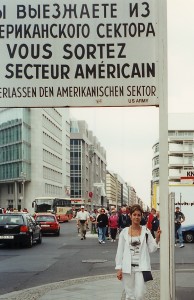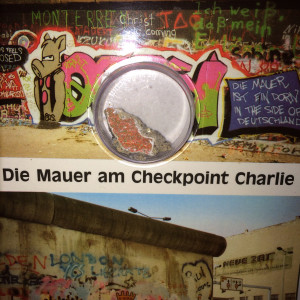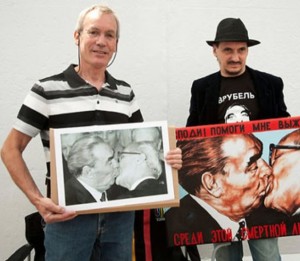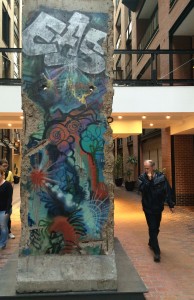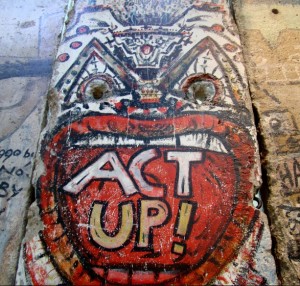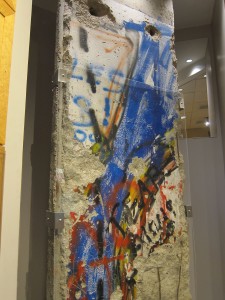Today is the 26th anniversary of the start of the Velvet Revolution, a peaceful student-led anti-government protest movement that led to the fall of communism in Czechoslovakia in December 1989. The name of the revolution stemmed directly from Lou Reed’s Velvet Underground, the house band of Andy Warhol’s Silver Factory art gallery/performance space in the 1960s. The Velvets’ stripped-down, subterranean sound and nihilistic attitude made them a favorite among avant-garde Czechs seeking mind-expanding alternatives to bland Soviet-spun art, literature, and music.
Within six weeks of the first demonstration on November 17, a playwright-poet-philosopher who had been imprisoned as a leading dissident became the country’s first democratically elected president in 41 years. His name was Vaclav Havel. He loved rock and roll, and was undoubtedly the first head of state to invite rockers to share their ideas. The photo above shows him with Lou Reed, Frank Zappa, and the Rolling Stones: all the president’s men.
During a trip to the U.S. in either 1967 or 1968, Havel bought a copy of a Velvet Underground album; no one is really sure if it was the band’s debut disc or “White Light/White Heat.” Said music writer Rob Jovanovic, “Havel took it home, along with Frank Zappa’s debut, and managed to smuggle it through Customs. Soon it was being copied and passed around the Prague underground, influencing the avant-garde set to play secretive gigs around the capital…” When Havel met Reed for the first time, early in his presidency, he was rumored to have said, “Did you know I am president because of you?” Following their first encounter, the hard-to-impress Lou Reed described Mr. Havel as a “heroic, intellectual, music-loving amazing person.”
The very serious Frank Zappa, whom Havel appointed a special “cultural ambassador,” was overcome with emotion when the president told him that Czechs used to be beaten by the Secret Police for listening to his music. In fact, Zappa’s song “Plastic People” inspired the name of a popular dissident Czech band, The Plastic People of the Universe, formed in 1968 following the Soviet clampdown that ended Czechoslovakia’s short-lived Prague Spring. Following the arrest and imprisonment of the group’s members in 1976, Havel declared that the Plastics were defending “life’s intrinsic desire to express itself freely, in its own authentic and sovereign way.” This led to the creation of a human rights organization known as Charter 77, a group of 242 petition signers who called for the human rights guaranteed under the 1975 Helsinki accords. Havel’s role in this movement, and his subsequent creation of the Committee for the Defense of the Unjustly Prosecuted in 1979, led to multiple imprisonments.
The Rolling Stones, bad-boys of the British rock scene, appealed to Havel’s rebellious nature. “For me, the Rolling Stones have always been a sort of counterweight to the more amiable, more lyrical and often more easygoing Beatles,” the president told Rolling Stone writer Roman Lipcik in the magazine’s October 4, 1990, issue. “I used to listen to their music often. Songs like ‘Satisfaction’ can hardly be forgotten.”
The Stones invaded Prague on August 18, 1990, three days before the twenty-second anniversary of the Soviet-led invasion of Czechoslovakia. Mick Jagger appeared on Czech state TV with a rallying cry: the Stones are rolling into town! Posters covered the city, announcing the tanks are rolling out! Keith Richards noted the president’s playful side: “We gave Vaclav this little white remote control with a tongue on it. He walked around lighting up the palace, and suddenly statues came alive. He was like a kid, pushing buttons and going, whoa!”
Czechoslovakia split into two separate entities in early 1993: the Czech Republic and Slovakia. I made 10 business trips to the CR in the early ’90s, during the height of Prague Spring Redux. I never had a chance to encounter any of my rock idols while there, but I could feel the spirit of rock and roll in my soul as I walked the cobblestone streets of marvelous, mysterious Prague, knowing that music truly did bring power to the people.
RIP, President Havel: October 5, 1936 – December 18, 2011.
RIP, Frank Zappa: December 21, 1940 – December 4, 1993.
RIP, Lou Reed: March 2, 1942 – October 27, 2013.
Here are the Plastic People of the Universe, with their rendition of the Velvet Underground’s “Run Run Run.”
© Dana Spiardi, Nov 17, 2015
]]>
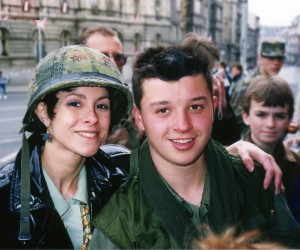 On May 4, 1991, the people of Plzen, Czechoslovakia, were celebrating “American Day” to mark the 46th anniversary of their city’s liberation from the Nazis by General George S. Patton’s U.S. Army at the end of World War II. It was a major event, and I was lucky to be there to take part in it.
On May 4, 1991, the people of Plzen, Czechoslovakia, were celebrating “American Day” to mark the 46th anniversary of their city’s liberation from the Nazis by General George S. Patton’s U.S. Army at the end of World War II. It was a major event, and I was lucky to be there to take part in it.
I had arrived in Czechoslovakia on April 25 to begin a public relations campaign on behalf of Westinghouse Electric Corporation. At that time, my company was hoping to form a joint venture with a Plzen firm – Skoda – for the purpose of producing power generation equipment. When I heard about the American Day celebration scheduled to take place on May 4, I saw a PR opportunity I couldn’t pass up.
 With the help of a Czech businessman I chanced to meet in Prague, I began working with Plzen city officials to secure two exhibit booths to serve as Westinghouse hospitality areas during the two-day event. Knowing I’d need plenty of assistants, I visited the American Hospitality Center in Prague and hired four young Czech students to run errands and act as interpreters. Now, what’s an exhibit booth without trinkets and other giveaways? I phoned headquarters back in Pittsburgh (no easy task, given the horrible telephone connections) and asked my colleagues to FedEx a box of Westinghouse logo-embossed items, such as frisbees, cups, hats, buttons, and tote bags, as well as large company banners to display in the booths.
With the help of a Czech businessman I chanced to meet in Prague, I began working with Plzen city officials to secure two exhibit booths to serve as Westinghouse hospitality areas during the two-day event. Knowing I’d need plenty of assistants, I visited the American Hospitality Center in Prague and hired four young Czech students to run errands and act as interpreters. Now, what’s an exhibit booth without trinkets and other giveaways? I phoned headquarters back in Pittsburgh (no easy task, given the horrible telephone connections) and asked my colleagues to FedEx a box of Westinghouse logo-embossed items, such as frisbees, cups, hats, buttons, and tote bags, as well as large company banners to display in the booths.
 Oh, and we needed music – preferably American music. I had seen a Dixieland Band comprised of Czech musicians busking on the Charles Bridge in Prague, and hired them to provide entertainment near our booths. And no exhibit area is complete without booze. So, I sent the Czech students on numerous trips to the huge local brewery to bring back cases of beer. And not just any beer, mind you. This was Plzen, where brewers began making the world-famous Pilsner Urquell beer in 1892.
Oh, and we needed music – preferably American music. I had seen a Dixieland Band comprised of Czech musicians busking on the Charles Bridge in Prague, and hired them to provide entertainment near our booths. And no exhibit area is complete without booze. So, I sent the Czech students on numerous trips to the huge local brewery to bring back cases of beer. And not just any beer, mind you. This was Plzen, where brewers began making the world-famous Pilsner Urquell beer in 1892.
The sound of New Orleans jazz filled the air as I distributed the various goodies to the revelers, who proudly wore the original uniforms their liberators had left behind in 1945. Like all citizens of Soviet Bloc countries, the Czechs had been cut off from American culture for 50 years, and watching them celebrate the USA in this manner was a moving experience.
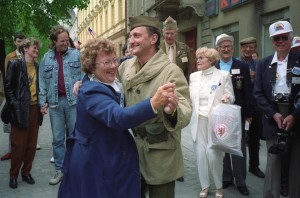 At one point during a ceremony, an official led the people of Plzen in a prayer of gratitude. In the background, I could see the old stone buildings still scarred with bullet holes from WWII battles. I was experiencing history in a way I’d never imagined.
At one point during a ceremony, an official led the people of Plzen in a prayer of gratitude. In the background, I could see the old stone buildings still scarred with bullet holes from WWII battles. I was experiencing history in a way I’d never imagined.
My first attempt to organize an event in a newly-democratic country proved quite challenging, given the short deadline, poor telecommunication systems, and my inexperience in the world of international public relations. And even though the joint venture with Skoda never materialized, Czechs had their first exposure to the Westinghouse name, and their first taste of American-style promotion.
© Dana Spiardi, May 6, 2015
]]>
Right on, Jules. Even though I shed a tear each and every December 8th – the date of John’s murder in 1980 – this year I’d like to present an upbeat memorial to the man whose music changed my life. How about a little story about his influence on the city of Prague, the capital of the Czech Republic, where the Lennon Wall – Lennonova Zeď – stands as a symbol of freedom.
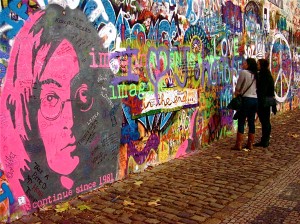 John was a voice of peace all over the world – even in the Communist-controlled countries of the former Soviet Union. The Commies tried their best to halt the influx of Western pop culture and fashion, but no Iron Curtain or Berlin Wall could keep out the Beatles. All the kids knew of them. And if you had black market connections, you could get your hands on one or two of their records — or at least a bootleg made from smuggled-in originals.
John was a voice of peace all over the world – even in the Communist-controlled countries of the former Soviet Union. The Commies tried their best to halt the influx of Western pop culture and fashion, but no Iron Curtain or Berlin Wall could keep out the Beatles. All the kids knew of them. And if you had black market connections, you could get your hands on one or two of their records — or at least a bootleg made from smuggled-in originals.
Enterprising music lovers routinely duplicated records using a device known as a roentgenizdat to press sound grooves onto the acetates of discarded x-ray plates. Imagine placing a film of Uncle Vladimir’s spleen on the turntable and rocking to “Abbey Road.”
The news of John Lennon’s murder in December 1980 sent shock waves around the world. In Prague, young people paid their respects by establishing an “unofficial” memorial to the fallen Beatle. They singled out a large wall at Grand Priory Square, and began covering it with beautiful graffiti images of John and his lyrics. The more rebellious of the lot – inspired by his message of “Power to the People” – also used the wall as a canvas on which to scrawl their grievances, particularly against Gustáv Husák, who ruled the country (then known as Czechoslovakia) – from 1969 through 1991.
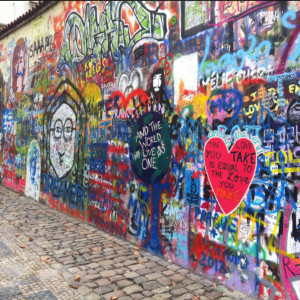 Husák succeeded President Alexander Dubček, whose liberal policies brought about the famous Prague Spring of 1968 — a period of relative freedom that effectively ended when Moscow rolled its tanks into the city’s Wenceslas Square as a clampdown on any burgeoning democracy. With Dubček soon banished, Husák reversed his short-lived policies and purged the country’s Communist Party of all its liberal members. The Czechs’ brief taste of freedom was gone.
Husák succeeded President Alexander Dubček, whose liberal policies brought about the famous Prague Spring of 1968 — a period of relative freedom that effectively ended when Moscow rolled its tanks into the city’s Wenceslas Square as a clampdown on any burgeoning democracy. With Dubček soon banished, Husák reversed his short-lived policies and purged the country’s Communist Party of all its liberal members. The Czechs’ brief taste of freedom was gone.
Flash forward 20 years: young men and women were increasingly aggravated by Husák’s growing conservatism. In the fall of 1988 they took to the Lennon Wall, airing their complaints in the form of anti-government graffiti. This and other acts of protest led to a huge clash between the police and hundreds of students on the city’s treasured Charles Bridge. The protestors called their activist ideology “Lennonism.” Czech authorities denounced the rabble rousers as crackpots, alcoholics, and proponents of Western capitalism. That episode was one of several that gave way to the Velvet Revolution, which culminated in the end of communist rule in November 1989.
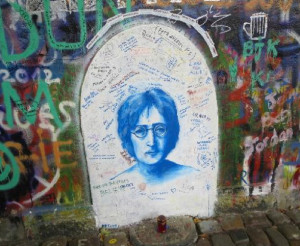 But despite its role in socio-political discourse, the wall never lost its original purpose: as a memorial to John’s life, music and messages. Czech authorities occasionally painted over the images, hoping to end the graffiti. But their efforts were useless. By the next day it was filled up again with Lennonisms. I had a chance to see what is perhaps the most powerful and famous graffiti portrait of John (the photo in the header above) when I first discovered the wall in 1991. Today, the memorial is a big tourist attraction – one that wasn’t listed in any of the city guides when I first set foot there.
But despite its role in socio-political discourse, the wall never lost its original purpose: as a memorial to John’s life, music and messages. Czech authorities occasionally painted over the images, hoping to end the graffiti. But their efforts were useless. By the next day it was filled up again with Lennonisms. I had a chance to see what is perhaps the most powerful and famous graffiti portrait of John (the photo in the header above) when I first discovered the wall in 1991. Today, the memorial is a big tourist attraction – one that wasn’t listed in any of the city guides when I first set foot there.
John would have loved Prague. I often think about how thrilled he would have been to know that people living in an oppressed society bucked authority by artistically promoting his messages of peace and love, in pursuit of freedom. “Give peace a chance?” Yes, they certainly did.
© Dana Spiardi, Dec 8, 2013
Header photo by Kevin McCann
]]>
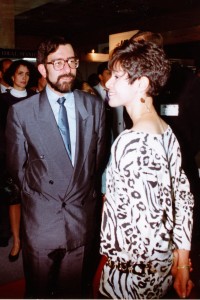 Westinghouse’s high-profile nuclear plant upgrade project in Bulgaria generated a lot of media attention and I was often thrust into the spotlight. My interviews and photos appeared in a dozen Bulgarian newspapers through the years. I even appeared on Bulgarian television nightly news! (See clip below.)
Westinghouse’s high-profile nuclear plant upgrade project in Bulgaria generated a lot of media attention and I was often thrust into the spotlight. My interviews and photos appeared in a dozen Bulgarian newspapers through the years. I even appeared on Bulgarian television nightly news! (See clip below.)
One of my tasks involved organizing the company’s participation in Bulgaria’s International Plovdiv Fair from 1991 through 1995. Our large exhibit space gave us a venue for meeting with customers, media and government officials. At left I’m talking to former Prime Minister Filip Dimitrov at the fair in 1992.
During that same year I visited the Soviet-designed Kozloduy nuclear plant. A May 1992 issue of Time magazine featured a cover story on the facility, titled “Europe’s Nuclear Nightmare.” The feature began with a series of quotes from a disgruntled nuclear plant worker who said the plant “could blow up at any minute.” Because Westinghouse was contracted by the Bulgarian utility company to upgrade the plant’s safety systems, Kozloduy management asked me to prepare a policies and procedures document that would help the utility improve its public information programs and prevent leaks to the press.
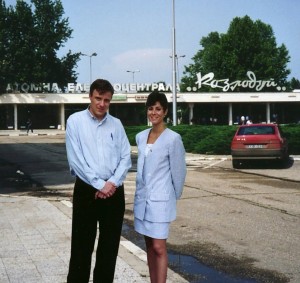 So, what does one wear when visiting a nuclear nightmare? How about a pin-striped, seer-sucker suit and four-inch heels. As usual, I was inappropriately dressed for walking through an industrial area. Later, I cracked open my forehead as I was getting in the car to leave the facility. This nuclear accident caused quite a stir, as plant workers poured out of the building to help me. Oh well, at least I can say my hot, home-style lunch in the plant cafeteria was the best meal I’ve ever eaten at a nuclear facility. Pictured in the photo with me is my friend Boyan Setchensky, the brilliant engineer from our office in Sofia, Bulgaria.
So, what does one wear when visiting a nuclear nightmare? How about a pin-striped, seer-sucker suit and four-inch heels. As usual, I was inappropriately dressed for walking through an industrial area. Later, I cracked open my forehead as I was getting in the car to leave the facility. This nuclear accident caused quite a stir, as plant workers poured out of the building to help me. Oh well, at least I can say my hot, home-style lunch in the plant cafeteria was the best meal I’ve ever eaten at a nuclear facility. Pictured in the photo with me is my friend Boyan Setchensky, the brilliant engineer from our office in Sofia, Bulgaria.
© Dana Spiardi
]]>